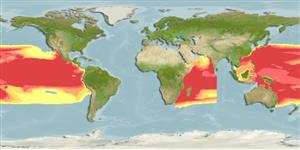Common names from other countries
Environment: milieu / climate zone / depth range / distribution range
Ecologia
marinhas bentopelágico; intervalo de profundidade 1 - 620 m (Ref. 58302). Deep-water
Pacific Ocean: Okinawa (Ryukyu Islands), Fiji and Tuvalu (Ref. 12596), Hawaii. Indian Ocean: western part of equatorial zone.
Tamanho / Peso / Idade
Maturity: Lm ? range ? - ? cm
Max length : 47.0 cm SL macho/indeterminado; (Ref. 559)
Espinhos dorsais (total) : 0; Raios dorsais moles (total) : 33 - 35; Espinhos anais: 0; Raios anais moles: 24; Vértebras: 17 - 23. Body color dark-brown to black. Scales on body and head spineless. Scaleless areas above and behind the eye. Caudal fin rounded in young and juveniles, forked in adults. Attains 47 cm SL.
Benthopelagic (Ref. 58302). Maximum depth reported taken from Ref. 129050.
Life cycle and mating behavior
Maturities | Reprodução | Spawnings | Egg(s) | Fecundities | Larvas
Masuda, H., K. Amaoka, C. Araga, T. Uyeno and T. Yoshino, 1984. The fishes of the Japanese Archipelago. Vol. 1. Tokai University Press, Tokyo, Japan. 437 p. (text). (Ref. 559)
Categoria na Lista Vermelha da IUCN (Ref. 130435)
CITES (Ref. 128078)
Not Evaluated
Ameaça para o homem
Harmless
Utilização humana
Ferramentas
Relatórios especiais
Descarregue XML
Fontes da internet
Estimates based on models
Preferred temperature (Ref.
115969): 13.9 - 26.9, mean 20.9 (based on 400 cells).
Phylogenetic diversity index (Ref.
82804): PD
50 = 0.7500 [Uniqueness, from 0.5 = low to 2.0 = high].
Bayesian length-weight: a=0.01413 (0.00737 - 0.02705), b=2.95 (2.77 - 3.13), in cm Total Length, based on LWR estimates for this species & (Sub)family-body (Ref.
93245).
Nível Trófico (Ref.
69278): 4.0 ±0.57 se; based on food items.
Resiliência (Ref.
120179): Médio, tempo mínimo de duplicação da população 1,4 - 4,4 anos (Preliminary K or Fecundity.).
Fishing Vulnerability (Ref.
59153): Moderate vulnerability (43 of 100).
